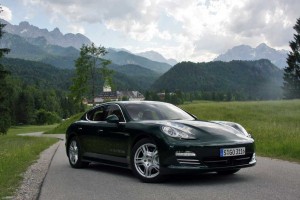
Porsche raised plenty of eyebrows when it announced plans to produce an all-new, four-door sports car, what's become the Panamera.
This time of year, things are quiet in the verdant Bavarian mountainside surrounding the old castle of Schloss Elmau. Wander the hilly grounds and you’ll hear cowbells, perhaps the buzz of bees and the distant roar of glacier-fed streams. But for a few days, this past week, hikers were also likely to catch the occasional revving of a big V-8, followed by the chirp of rubber biting into pavement, as a Porsche Panamera’s Launch Control system set the new 4-door sports car into motion.
We had the good fortune to test drive some of the first of the new cars off the line, putting all three versions of the 2010 Porsche Panamera through their paces on a winding and convoluted course that led us out from the urban center of Munich into the open Alpine countryside near the German-Austrian border. In three days of driving on dense city streets, open Autobahns and twisty mountain roads, we got a sense of what buyers will discover when they fire up a Panamera for the first time.
 Since Porsche first announced plans to build a “four-door sports car,” mid-decade, it has heard from many a skeptic convinced it would put the German maker on a quick road to ruin. That is, of course, the same sort of thing critics predicted before the debut of the big Cayenne, now Porsche’s best-selling product in its biggest market, the U.S. While the debate over the very concept of a sport-ute/sports car is likely to continue, there’ll be few who’ll be able to denigrate the new Panamera’s pedigree. It is not just a serious sports car but a pure Porsche – just one, as a company executive suggested, in which you now have the opportunity to share the experience with three of your friends.
Since Porsche first announced plans to build a “four-door sports car,” mid-decade, it has heard from many a skeptic convinced it would put the German maker on a quick road to ruin. That is, of course, the same sort of thing critics predicted before the debut of the big Cayenne, now Porsche’s best-selling product in its biggest market, the U.S. While the debate over the very concept of a sport-ute/sports car is likely to continue, there’ll be few who’ll be able to denigrate the new Panamera’s pedigree. It is not just a serious sports car but a pure Porsche – just one, as a company executive suggested, in which you now have the opportunity to share the experience with three of your friends.
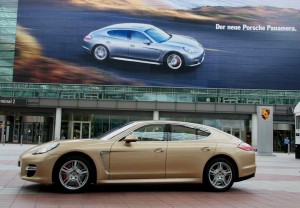
TheDetroitBureau.com picked up the Panamera at Munich airport before heading into the Bavarian Alps for three days of driving.
You’ll know the 2010 Panamera is a Porsche from first glance. It bears many of the automaker’s classic cues, such as the broad, rear shoulders, the steeply-raked windshield and the low-slung snout with the big air scoop, rather than a grille. From the front, there’s the unmistakable visual DNA of a 911. The rear is reminiscent of the old 928, with, on the Panamera, a hatchback that, to some, might seem a bit bulbous.
Is the new car pretty? Since the production model made its long-awaited debut, at this year’s Shangai Motor Show, that has also triggered an unusual degree of debate. Among the small group of media colleagues who attended this past week’s drive, sentiment ran from “a bit ungainly” to “strikingly handsome.” Our own opinion comes in closer to the latter. Porsche has accepted the need for some visual concessions in order avoid compromising Panamera’s functionality and performance.
The fact is, this is a big automobile, gaining roughly two-feet, nose-to-tail, over the 911. The 2010 Porsche Panamera is not only longer than t Cayenne, it is roughly the length of a Chevrolet Tahoe. As a result, this is no 2+2, a four-seater in name only. There was no problem sliding my 6’2 frame through the rear doors, and I was more than comfortable spending an hour in one of the back seats – without having to ask the passenger in front to slide so far forward they’d have put their knees up in their own face.
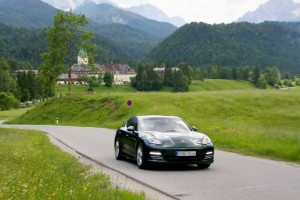
Hit launch control on the 2010 Porsche Panamera and onlookers will likely see little more than a blur as you blast off.
One of the biggest surprises was the amount of rear seat headroom, notably more than the visually delightful but functionally compromised Mercedes-Benz CLS. Oh, and add the fact that the trunk proved big enough to handle two well-stuffed suitcases, a large camera bag and a couple smaller duffles. With the rear seats up, you’ll be able to stuff in 15.7 cubic feet of cargo, 44.6 cf with the seats down.
Move into the driver’s seat for the first time and you’ll discover what is without question the most lavish and stylish cockpit Porsche has ever brought to market. The sports seats almost meld to your body, providing plenty of support without the hardness we often find in sports car seating. There’s been extraordinary attention to detail, with beautiful hand stitching of the leather dashboard, and striking use of wood and metal inserts.
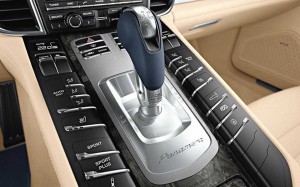
Porsche choose to skip the iDrive-style controllers other luxury makers have adopted, opting to give the driver immediat,e fingertip control of all critical functions, such as Sport Mode.
For the driver, there’s one of the most useful instrument clusters we’ve ever seen, a five gauge arrangement that includes a circular navigation screen, a smaller close-up of what can be seen in the big display at the top of the center stack. The layout is easy to read and minimizes the time you’ll need to take your eyes off the road.
The interior’s visual center of gravity is the center console, which features not only the gear shifter, a minimally functional cupholder (two more can be found folded away above the front passenger’s knees) and change holder, but close to two dozen different buttons designed to operate the myriad technical features, standard and option, engineered into the 2010 Porsche Panamera.
These allow you to adjust shock dampers, for example, raise or lower the rear wing, switch to Sport or Sport Plus mode, and turn the car’s Start/Stop function on or off. Porsche consciously chose not to go with an iDrive-like controller, arguing that this admittedly complex layout provides more immediate control of all the various functions and features. The layout can be a bit overwhelming, at least at first, but it quickly becomes intuitive.
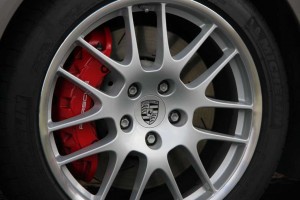
Porsche offers standard 18" wheels on the Panamera S and 4S and 19" on the Turbo. Massive, vented brakes are there to scrub off speed in a hurry and show little fade, but optional ceramic carbon-carbon brakes are also available.
The addition of a Start/Stop function, notably marks the first time this feature has been integrated into a luxury sports car. For those not familiar with the technology, it automatically shuts off the engine when you idle at, say, a stoplight. Lift your foot off the brake and the engine instantly re-starts, with barely a shudder.
Porsche officials claim Start/Stop should boost urban fuel economy by up to 10 percent, though we didn’t have the opportunity to test that bold claim. (The automaker pointedly declined to provide any mileage numbers for the new sedan, choosing to wait for U.S. government certification.) Curiously, on versions of the Panamera shipped State-side, the driver will have to activate the Start/Stop system. It will default on in the rest of the world. Personally, we’d prefer that approach State-side, as well.
There will be three basic versions of the Panamera, the “base” V-8-powered S, the all-wheel-drive 4S and the top-line Turbo. What surprised us, a bit, was to discover that virtually everything on a long list of features would have to ticked off on the option box, down to such seemingly essential details as a CD changer, never mind the state-of-the-art, studio quality 16-speaker, 1000-watt Burmester sound system.
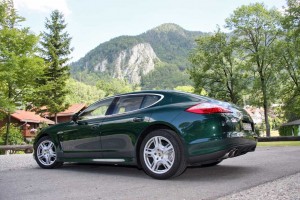
The rear end of the 2010 Porsche Panamera is reminiscent of the old 928, but while controversial, it delivers phenomenal functionality, providing space for four large adults and lots of luggage.
It is, without question, a long list, though Porsche did not try to have the absolute last word when it comes to technology. There’s a rearview camera, useful considering the car’s relatively limited rear visibility, but no blind spot monitoring system, for example, nor lane departure warning – devices we did just fine without, thank you.
Where Porsche engineers ultimately focused their attention was where you’d expect of the Stuttgart-based company: on the Panamera’s performance, handling and drive dynamics.
There’s no question this is a large car. You’re certainly aware of its dimensions when you’re racing along the narrow, winding roads that curve through the Alpine countryside. Yet it doesn’t handle “big,” so to speak. The 911 lineage is immediately obvious as you carve a corner with finesse. The Panamera steers precisely where you want it with just the right amount of effort and none of the of the notchiness you find with some other sports cars.
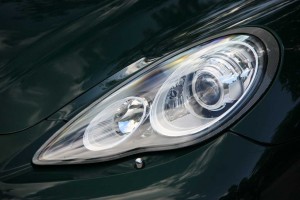
From the big air scoop and windswept headlights back, you'll immediately know this is a Porsche.
There’s a subtle but noticeable difference between the three different models. The 4, for example, boasts the purist handling of the trio, while the AWD system on the 4S requires the subtlest bit of manhandling in the tighter corners. At roughly 4400 pounds, the Turbo is the heaviest of all the versions – roughly 400 pounds more than the S — and you can feel that on the road, albeit every so slightly.
The new adjustable shocks are part of a slick package that includes both the Porsche Active Suspension Management System and the optional Porsche Dynamic Chassis Control system, which will virtually eliminate body roll in even the tightest corners. Among the slick tricks incorporated into the PDCC is a pair of active roll bars that engage only while cornering.
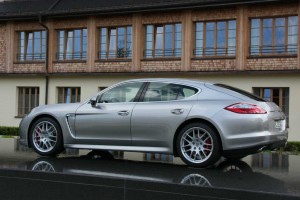
Porsche expects to sell at least 20,000 Panameras annually, which would make it on of the marque's best-sellers.
Both the S and 4S share the same 400-horsepower, 396 pound-feet 4.8-liter V-8, though the latter model adds all-wheel-drive to the arrangement. The top-line package bolts on a pair of turbochargers that give you 500 hp and one of the flattest, most immediate torque curves you’ve ever experienced. The 516 lb-ft of torque from the Turbo will get you from 0 to 60 in just under 4 seconds and keep going to 188 mph.
All U.S. versions come with the Porsche PDK system, an electronically-shifted dual clutch 7-speed manual gearbox that can be operated as seamlessly as an automatic or shifted via the steering wheel-mounted paddles. (In Europe, the automaker also offers a conventional 6-speed manual.)
At least one other powertrain is likely to make it to the States, at some point. Porsche will introduce a hybrid version of the Cayenne next year and hints strongly that this gasoline-electric package will be offered on the Panamera sometime shortly afterwards.
If you’re looking for the feel of raw power, the best route is to find a flat, smooth stretch of asphalt and switch on the Turbo’s Launch Control system. Point the nose, grab the wheel and stomp on the brake at the same time pressing the accelerator to the floor. The engine revs to 4800 RPMs before signaling it’s active in the smaller navigation display. Release the brake and you’re in for Mr. Toad’s Wild Ride. Warn your passenger. When I occupied the co-pilot seat, the closest experience I could bring to mind was the snap of the neck and the punch to the solar plexus when you bring an aerobatic glider out of a steep dive with a yank on the stick.
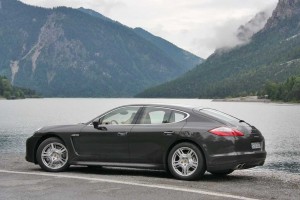
Porsche offers three different powertrains on the 2010 Panamera -- but a fourth is coming, a hybrid similar to what will be introduced on the Cayenne SUV next year.
Mercifully, my co-driver and I agreed to limit the number of times we’d put each other through this extreme. But we found other ways to experience the sedan’s unbridled power. On a long stretch of Autobahn, we squeezed the throttle to the floor and left it there, the speedometer quickly nudging 150, 180, 200, 240 kmh – about 150 miles an hour. The stability of the Panamera platform was absolutely uncanny and inspiring. We’d have kept it going had we not run out of asphalt.
In reviewing the Panamera, the word, “functionality,” keeps popping up, and to complete the picture consider you can order a foldaway tow hitch for a car that can haul up to 4850 pounds. There are mounts for a roof rack, as well.
All this comes at a price, of course, and a steep one. The 2010 Porsche will formally go on sale in the U.S. on October 17th, the S carrying a sticker of $89,800, the 4S going for $93,800 and the Turbo $132,600. (Anticipate about $800 more for delivery charges – and quite a bit more if you’re going to start ticking the seemingly-endless option boxes.
Nonetheless, after spending three days behind the wheel of the Panamera, we can readily understand why the automaker has such confident ambitions for its newest entry – it hopes to move at least 20,000 a year, which would make it one of the brand’s best-sellers. While it may not be the most beautiful 4-seat sports car ever designed, it certainly is the most functional, and perhaps one of the few that can serve as a true daily driver. We’d be hard-pressed to find a better option.
